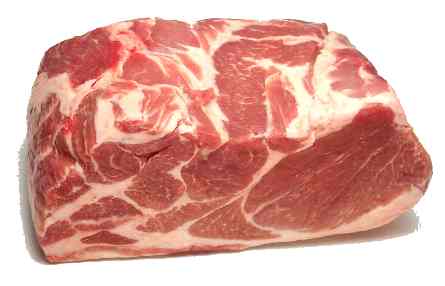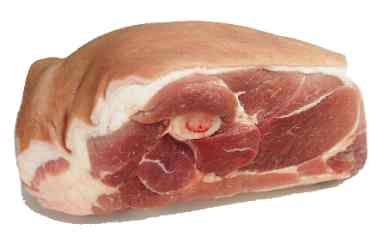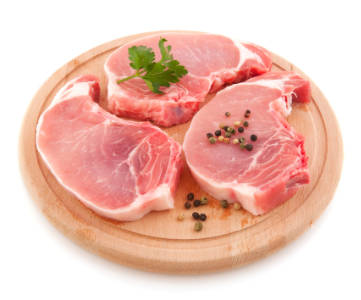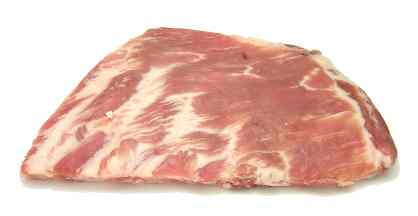Pork Category

Years ago, cookbooks instructed readers to cook pork until it reached a scorching internal temperature of 180 degrees. Back then, the pork chops that landed on our plates were dry and leathery, and we often used lubricants like applesauce or sauerkraut to help get them down. After more careful research, food scientists now tell us that pork is safe to eat after it reaches an internal temperature of 160 degrees. At that temperature, pork can be juicy, tender, and flavorful.
Boston butt
This economical, rectangular roast is the cut of choice for pulled pork barbecue, since it's marbled with enough fat to keep the meat moist while cooking. You can buy it bone-in or boneless.
Learn morefresh pork leg
This makes a great roast for a large crowd. It's usually cured as ham, so you might have to special-order it to get it fresh. It's sold either boneless or bone-in, and either whole or halved. The bottom half is called the shank portion = shank roast = leg roast, while the upper is called a top leg roast = inside roast = butt portion = pork leg butt = fresh ham butt = pork leg roast sirloin portion. A steak cut from the leg is called a fresh pork leg steak.
Learn morefresh pork leg steak
This is a steak cut from the middle of a fresh pork leg. It's economical, but a bit tough, so you might want to marinate it before grilling or broiling it. You can also slice it into strips and stir-fry them.
Learn morepork arm picnic
Southerners like to use this fatty, bony cut to make barbecued pulled pork. It's also available boneless. This is also a good, economical cut to get if you want to make ground pork, kabobs, or stir-fry strips.
Learn morepork back ribs
These ribs are meatier than spareribs, but they're not as meaty as country-style ribs. Allow 2/3 pound per person.
Learn morepork blade roast
This somewhat fatty, economical roast is sold either bone-in and boneless. If you buy it as a bone-in roast, make sure that the butcher has cracked the backbone between the ribs so it's easy to carve. Country-style ribs are cut from this piece.
Learn morepork blade steak
These are cut from the Boston butt, and they're a cheap and flavorful alternative to pork chops. They're a bit too tough to fry, but they're wonderful if slowly braised.
Learn morepork butterfly chop
This is a thick chop taken from the loin eye which is cut almost in half so that it forms a butterfly pattern when opened on the hinge.
Learn morepork center loin roast
For many cooks, this lean and tender cut makes the best pork roast of all. One drawback is that it includes part of the animal's backbone, which adds flavor but can make the roast hard to slice after cooking. One solution is to ask your butcher either to cut off the bone and tie it back on or to cut through the backbone in several places so that you can easily slice the cooked roast into chops. If the backbone is removed and the ribs are "Frenched" or trimmed of meat, this cut is called a rack of pork. To make a crown roast of pork, get two racks and tie them into a circular crown. Your roast will be moister if the butcher doesn't trim the big slab of fat that usually comes with this cut. The roast will be moister if you cut the fat off after the roast is cooked. Steaks cut from this roast are called pork loin chops or pork rib chops.
Learn morepork chop
Pork chops usually turn out juicier if they're thick and if they're attached to bone. Several different cuts are called pork chops. The most tender and expensive ones are the pork loin chop and the pork rib chop. Next in the tenderness hierarchy are the pork sirloin chop, pork top loin chop, and the pork loin blade chop. Pork arm steaks and pork blade steaks are relatively tough and fatty, but they're very flavorful. They're better if they're braised rather than grilled, broiled, or fried.
Learn morepork country-style ribs
These have more meat than spareribs or back ribs, but they aren't as easy to eat with fingers. Allow 1/2 pound per person. They come boneless (pictured) or bone-in.
Learn morepork cube steak
This is a relatively tough cut of meat, often from the shoulder, that the butcher tenderizes mechanically.
Learn morepork cubes
These are cubes that are put on skewers for grilling. Don't confuse cubes for kabobs with pork stew meat, which is too tough to grill.
Learn morepork loin blade chop
These are cut from the blade roast, which is the part of the loin that's closest to the shoulder. You can grill, broil, braise, or panfry them. Don't confuse this cut with the pork blade steak, which is cut from the Boston butt and is fattier.
Learn morepork loin chop
This is distinguished by a T-shaped bone that's off to one side. It's a great chop to grill, broil, or panfry.
Learn morepork roast
You can oven-roast several pork cuts. Many cooks think that the pork center loin roast is the best choice--it's moist, tender, and flavorful. Pork tenderloins are also popular because they're lean, tender, and boneless. As you move away from the center of the pig, the roasts become either bonier or fattier or less tender, but they're more economical and often packed with flavor. Good choices include the pork top loin roast, fresh pork leg, pork sirloin roast and Boston butt.
Learn morepork sirloin cutlet
These lean steaks are similar to sirloin chops, only meatier and boneless.
Learn morepork sirloin roast
This is a fairly lean and economical roast. A bone-in sirloin roast contains parts of the hipbone and backbone, so it's tough to carve. It's usually worth the extra money to get a rolled and tied boneless sirloin roast.
Learn morepork spareribs
These aren't as meaty as country-style ribs or back ribs, but they're popular at barbecues since they're easy to eat with your fingers. Allow 4/5 pound per person. St. Louis style ribs are spareribs that have been trimmed of the brisket bone.
Learn morepork stew meat
This are pieces of meat that are too tough to grill, broil, or panfry. They're best if cooked very slowly in a liquid.
Learn morepork tenderloin
This cut is lean, tender, and boneless, so it commands a high price. It's delicious roasted, grilled, or broiled as long as you don't overcook it. Tenderloins are usually sold in pairs, and sometimes cut up into tenderloin pieces. If there's a silver membrane on the tenderloin, remove it before cooking.
Learn morepork top loin roast
To make a boneless roast, the butcher puts two top loins together and ties them up, fat sides out.
Learn more























































































































































































































































































































































